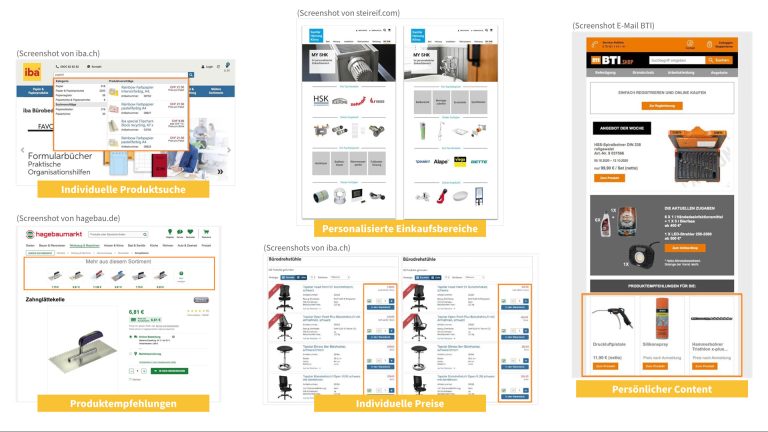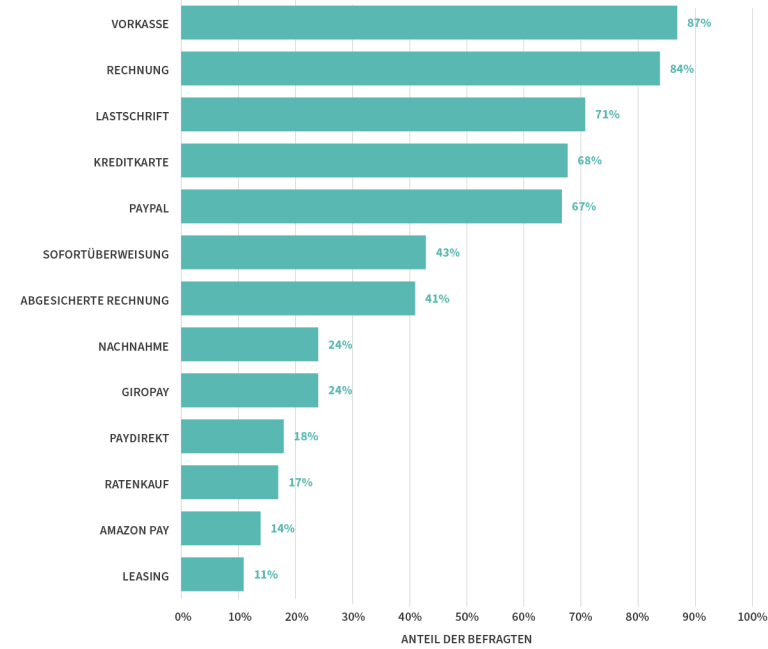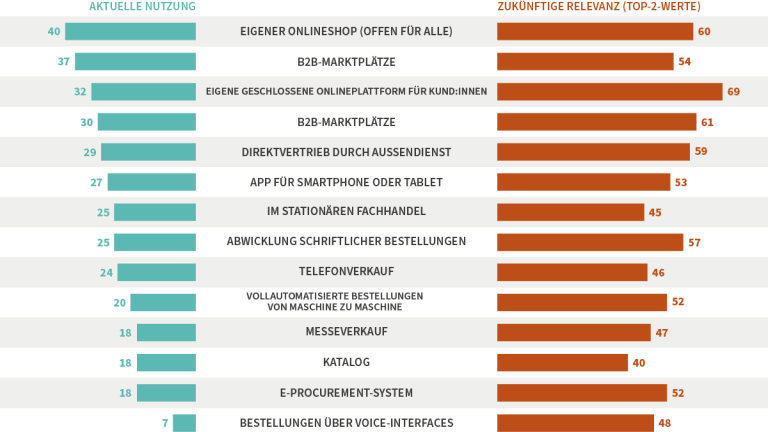E-commerce is a must-have in B2B. In order to continue building productive relations with their customers, companies need to offer outstanding customer experience. However, the digital maturity varies significantly depending on the company and industry. While some – driven by the Covid-19 pandemic – have just launched their first web shop, others are already working on the second or third generation. In this article, we take a look at the most important B2B e-commerce trends for 2023 to help companies keep an eye on market developments and compare them with their own approaches.
A common assumption has been that e-commerce in the B2B sector is only suitable for repeat purchases or purchases with low revenue. However, this assumption is increasingly being disproved as more and more B2B customers are willing to spend large amounts through digital channels. A study by McKinsey from 2022 shows that over a third of respondents are willing to spend £500,000 or more in a transaction through digital channels, a figure that has steadily increased over the past year.
B2B companies with a complex product range should therefore no longer view their corporate website solely as an information channel but should now consider selling machines and complex goods online.
More and more companies are counting on CPQ systems to digitize and automate their offer and sales processes. CPQ systems convince through three core functions: complex product configuration, pricing calculation, and extensive document and quote generation. On the other hand, e-commerce solutions excel in creating a holistic user experience, managing shopping carts, and processing payments.
CPQ and e-commerce are a combination that enables the easy online ordering of customized products. Therefore, for B2B companies, integrating product configuration into their website or online store will be rewarding when looking at future sales.

The two trends described earlier are accompanied by buyers needing support in selecting complex products. Visual elements are increasingly being used, when a traditional, mask-based configuration is no longer sufficient.
Users receive immediate visual feedback that allows them to assess whether the configured product meets their requirements. If the dimensions of individual components are known, a visual or even fully automated collision check is possible. Via augmented reality, configured products can be displayed directly in the actual installation space.
In the past, it was mainly the sales representative who knew exactly what his customers wanted. Traditional websites did not require personalization. Now that business customers also want to shop online this has changed. Many companies wonder how they can transfer their customer service to digital channels. We are all familiar with personalization, e.g., from the Amazon marketplace. It is one of the biggest revenue drivers in B2C e-commerce, for example, through personalized product recommendations.
In B2B, personalization is even more important due to the complex products and different customer needs. But what does personalization look like in this case? The following graphic provides an example of how it can be implemented.

A straightforward process is important for merchants and their B2B customers when choosing their preferred payment method. Equally important is the assurance that the chosen method corresponds to the respective target group. The most commonly used payment methods are:
These payment methods provide a good starting point if you want to reach the widest possible customer base as a B2B merchant. However, offering only the two most popular methods is not enough. For successful purchase transactions, customers expect a simple process and the option to choose their preferred payment method. Of course, there are significant industry differences when it comes to payment. For example, invoice payment dominates among industrial companies. Furthermore, cultural payment preferences in different countries must also be considered when internationalizing.

Last year, security in B2B e-commerce was a topic that repeatedly made the papers. The attack on Continental in 2022, in particular, showed how great the threat from hackers has become. E-commerce websites contain sensitive information and capital, so security gaps can pose an immense threat to B2B companies. Given the dramatic consequences, the times when this issue could be neglected are over!
Through a Direct-to-Consumer (D2C) offer, manufacturing companies can expand their sales opportunities in addition to their B2B business. This business model provides the opportunity to gain valuable information through direct contact with end customers, develop products, and position the brand better based on this.
D2C trade is not only interesting for start-ups and pure internet players but also for companies that have already established themselves in the B2B market, especially if they are already active in online commerce. However, digital direct sales come with new challenges. B2B companies need to develop new solutions, especially in the areas of fulfillment and logistics, but also in marketing. Modern, flexible e-commerce systems and a well-connected system landscape provide the ideal basis for this.
Today, B2B marketplaces already account for 16 percent of total revenue, and it is expected that they will continue to gain relevance in the future (Statista/Lohmeier 2023). One of their most significant advantages is the ability to attract new target groups. This means more revenue and the opportunity to reach global markets and test new products. Currently, mostly vertically structured platforms are emerging in competition with each other.
For example, a machinery manufacturer offers products, accessories, spare parts, services, and possibly even used machinery via the platform. This offer is complemented by suppliers of raw materials and semi-finished products, logistics service providers, auxiliary and operating materials suppliers, financing service providers, or software vendors. This lets the customer obtain all relevant goods and services related to the core product via the same platform.

Marketplaces are not the only manifestation of the platform economy. In all industries, new service offerings are emerging using digital platforms. They are intermediaries that connect two or more market participants and simplify their interaction using digital technology. They have become a dominant business model in the digital economy in recent years.
Seven of the ten most valuable companies worldwide have integrated platforms as a core component of their product and service portfolio. By now, even the German industry is on its way there. In some cases, statements like “We no longer want to sell products, but services” can be heard. The purely physical product offering is increasingly combined with digital offerings and services, transforming business models. According to the BDI (2023), B2B platforms ensure the future viability of the German industry.

HOLGER REIMSBACH
consultant digital business
McKinsey & Company (2022): Busting the five biggest B2B e-commerce myths.
Statista/Lohmeier (2023): Umfrage zum Anteil der Verkäufe im B2B-Handel nach Vertriebskanälen 2021. (URL: B2B-E-Commerce – Angebotene Zahlungsmethoden 2021 | Statista)
IFH Köln (2022): B2B-Marktmonitor 2022 – E-Commerce Umsätze, Unternehmen & Trends im B2B-Internethandel 2022.
BDI (2023): Digitale B2B-Plattformen “Made in Germany”: Für eine nachhaltige und digitale Wirtschaft.
This might also interest you